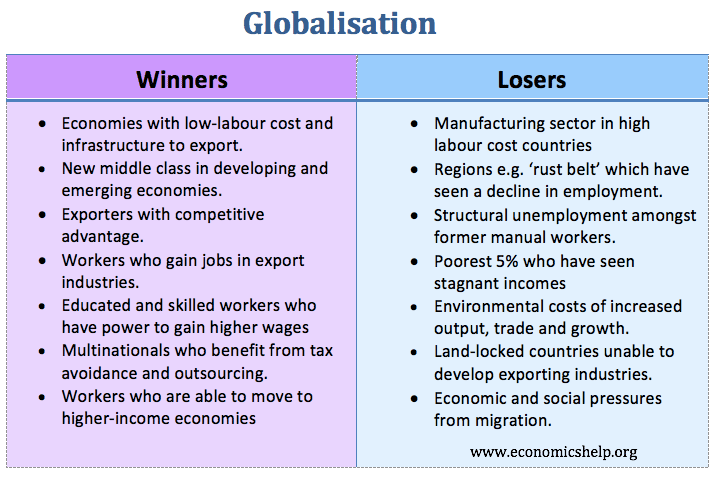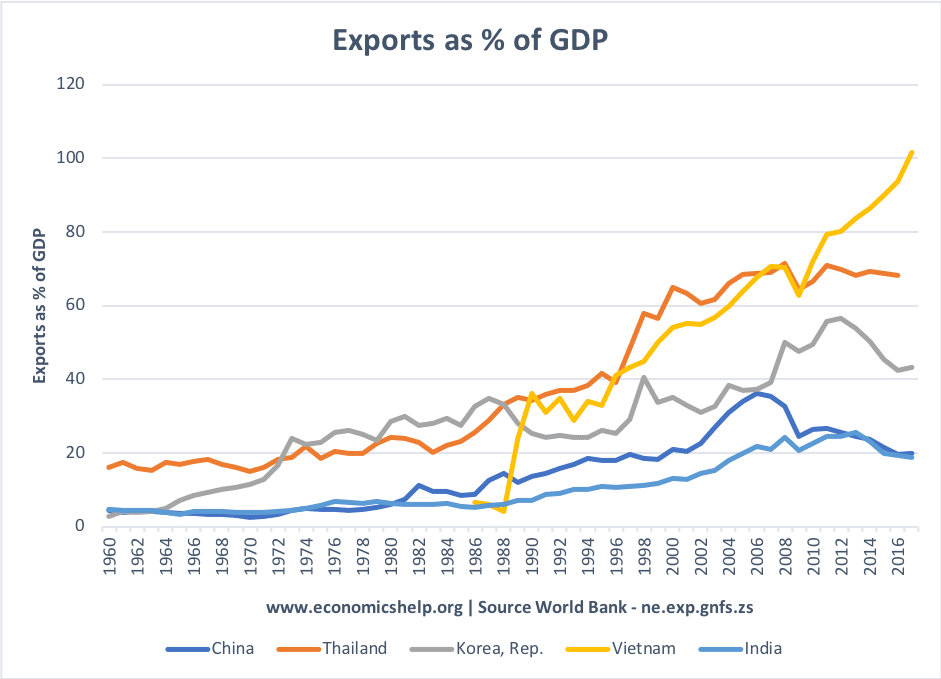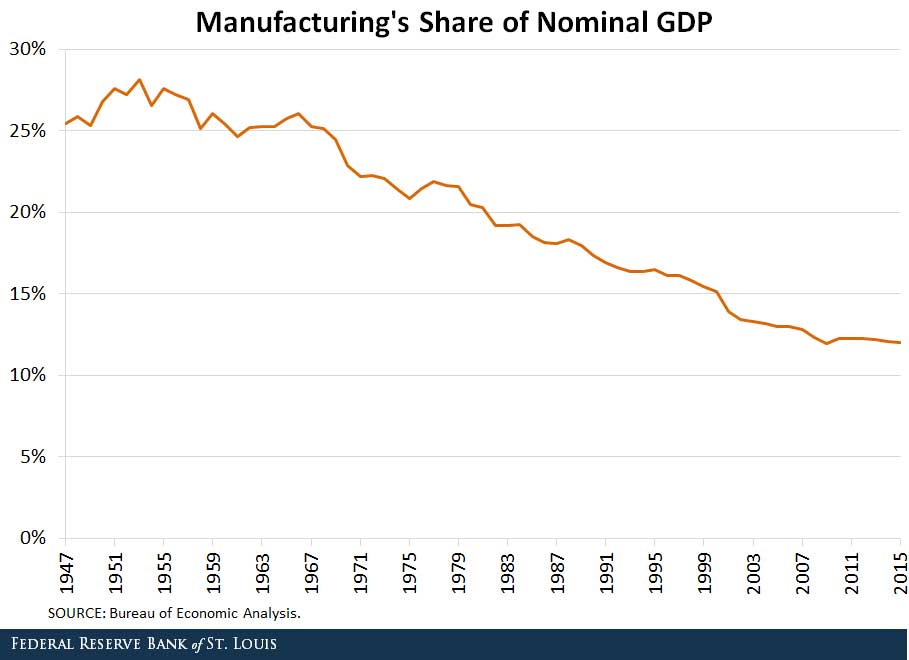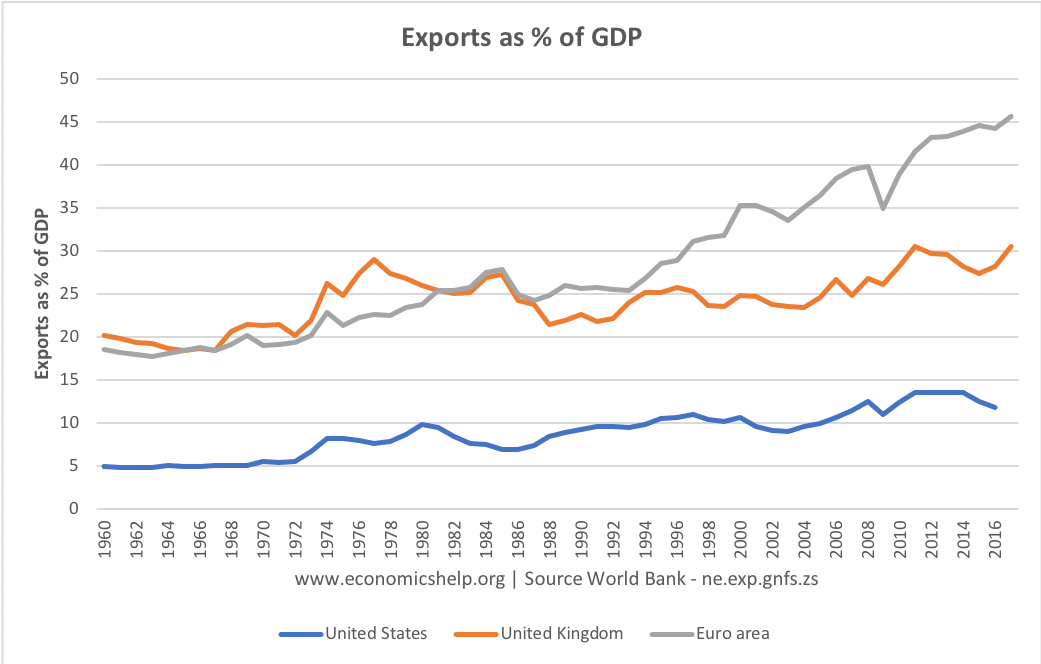Globalisation involves the increased integration and interdependence of the global economy. Since the 1960s, there has been an increased rate of globalisation, which has been characterised by rising trade, rising exports as % of GDP, greater movement of labour and capital, and an increased interdependence of the global economy.
Globalisation has benefitted some countries more than others. In particular, South East Asian countries, such as Vietnam, Korea and China have seen a growth in living standards due to their export boom. However, countries in Sub-Saharan Africa have struggled to experience improved living standards as they have not seen the same growth in exports.
In the developed world – the US, the UK and the Eurozone, globalisation has been a mixed blessing with some sectors of the economy (e.g. service sector) experiencing rapid growth, but some unskilled workers have been left behind as former manufacturing sectors decline due to greater global competition.

Winners
- Firms with a global comparative advantage, e.g. high-tech software firms
- Countries with low-cost labour and infrastructure to export (e.g. Korea, Vietnam, Thailand)

This shows the importance of exports to these developing economies. Since the mid-1980s, there has been a significant growth in exports as % of GDP, especially for countries like Vietnam, Korea and Thailand.
- Highest earners, who are in a position to negotiate higher wages. The World Bank found that between 1988 and 2008, the real income of the world’s top 1% of the world’s earners – went up by more than 60%. (World Bank)
- New middle class in emerging economies, who are experiencing rising real incomes
- Wealthy who can invest abroad and take advantage of lower tax rates.
- Multinational companies who can take advantage of tax breaks and lower cost labour abroad. For example, Amazon and Google have set up subsidiaries in countries like Ireland and Luxembourg to get lower tax rates. Also, production is increasingly globalised, e.g. Apple design in the US, but manufacture in China.
- Workers who gain employment in export industries.
- Consumers who benefit from lower prices.
- Greater movement of labour has made labour markets more flexible. For example, filling labour vacancies in health care with foreign born workers
Losers
- Unskilled manual labour who have seen a decline in employment opportunities with a structural change to the economy
- Average taxpayers who lose out from tax avoidance schemes of global multinationals.
- The environment which is experiencing global warming and loss of natural resources.
- Manufacturing sector in high-cost labour countries. Manufacturing companies in UK and US have seen a comparative decline as they struggle to compete with lower labour cost competitors.
- While top earners and the middle class have seen rising incomes, the World Bank found the poorest 5% of the world’s population have seen stagnant real incomes from the period 1988-2008. (World Bank)
- Developing economies who lack the infrastructure to developing exporting manufacturing sector. The agricultural sector has seen comparatively smaller growth in real earnings. Agricultural commodities have low-income elasticity of demand, so with rising real GDP, demand for agriculture does not rise a the same rate.
- Some countries have seen a ‘brain drain‘ as young skilled workers move to higher income countries. This is especially an issue for Eastern European economies which have seen a net outer migration to Western Europe. Net migration to Western Europe has created social pressures.
Winners and losers in the US economy

In the US, globalisation has led to a fall in the share of manufacturing as a % of GDP. This in itself is not a ‘bad’ thing. However, a rapid decline in one sector can lead to regional decline and structural unemployment. Areas in the US, have become known as the ‘rust belt‘ – former manufacturing cities which have struggled to compete with cheaper imports. Globalisation has accelerated this decline.
- On the other hand, globalisation has led to benefits from the US economy. Cheaper manufactured goods have kept consumer prices low, and with increased disposable income, other US firms have benefitted. But, the benefits have been unequally distributed. Furthermore, the US has been able to specialise in different sectors, such as finance. This has benefitted educated workers, who can gain good jobs in the service sector.

This shows that exports are a smaller percentage of the US economy. Part of this is due to the size of the US, there is more intra-US trade. While the Euro area has seen a rapid growth in exports due to Single Market.
Evaluation
- Sometimes globalisation is a ‘catch all’ issue blamed for all an economies problems. In reality, manufacturing sectors may still have declined – even with less globalisation.
- Globalisation is also quite a vague concept and it is not something new.
- It is worth considering ideas such as Schumpeter’s Creative destruction of Capitalism. Also, it is worth considering the “Luddite Fallacy“
- A big issue is not globalisation per se, but how we manage the impact of globalisation. It is possible that globalisation can play a key role in improving living standards for the poor, but left to market forces, it is no guarantee.
- There is a tendency to simplify the debate, e.g. in US manufacturing sector decline, finance has done relatively well. However, some US manufacturing firms are still very globally competitive, though the manufacturing process is now more global with different stages of production delegated to different economies.
Related

Hey can you give some examples of winners and losers of globalisation
Winners tend to be countries in the EU, North America and East Asia because globalisation is rather regional. See Mann 1997 to read more on that.
Losers are countries with low wages, working conditions etc. I realise the text says they are winners but in reality not so much. MNCs exploit this and the workers go through hell. So it depends what perspective you look at it from. Also, the companies that relocate or invest in LEDCs tend to not give as much profit back to the country, therefore the government also does not benefit as much as some think.
Thanks for the notes, I rate you no_1
I see countries in Africa losers because few countries in Africa have got multilateral & bilateral companies so they can’t compete with European countries and most of them are developing countries
Thank you for the notes have benefited alot